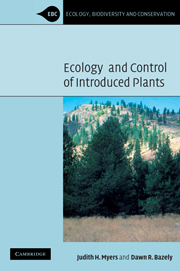Book contents
- Frontmatter
- Contents
- Preface
- 1 Introduction
- 2 Planet of Weeds: exotic plants in the landscape
- 3 Biological invasions in the context of plant communities
- 4 Predicting invasiveness from life history characteristics
- 5 Population ecology and introduced plants
- 6 Introduced plant diseases
- 7 Biological control of introduced plants
- 8 Modeling invasive plants and their control
- 9 Action against non-indigenous species
- 10 Genetically modified plants and final conclusions
- Appendix
- References
- Index
4 - Predicting invasiveness from life history characteristics
Published online by Cambridge University Press: 02 December 2009
- Frontmatter
- Contents
- Preface
- 1 Introduction
- 2 Planet of Weeds: exotic plants in the landscape
- 3 Biological invasions in the context of plant communities
- 4 Predicting invasiveness from life history characteristics
- 5 Population ecology and introduced plants
- 6 Introduced plant diseases
- 7 Biological control of introduced plants
- 8 Modeling invasive plants and their control
- 9 Action against non-indigenous species
- 10 Genetically modified plants and final conclusions
- Appendix
- References
- Index
Summary
What are life history traits?
Traits that affect the fitness of individuals directly are ‘life history traits’ (Stearns 1992). For plants, these include size and number of seeds, seed dormancy, growth pattern and the size or age at first reproduction. Plant species differ in how and how often they reproduce, how rapidly they grow, and their physical structure. These characteristics can influence the evolution, adaptation, population growth and the population dynamics of species. Some characteristics associated with variation of life history patterns are given in Table 4.1. These same characteristics could contribute to whether an introduced plant species might become established in a new area and then whether it might invade and outcompete the native plants. We are interested here to know if invasive plants have life history characteristics that contribute to their success. We will first consider some of the variation in life history characteristics that might be important.
The growth rate and time to first reproduction of plant species determine how quickly a population can grow. Characteristics that influence plant survival will determine the persistence of a species in a habitat. The growth form and root structure of a species will influence its ability to compete. Characteristics that influence whether plants outbreed, inbreed or reproduce asexually will determine the levels of genetic variation that they maintain, and thus how rapidly they might respond to changing selection and varying environmental conditions. The persistence of seeds in the soil can buffer plants against poor conditions.
- Type
- Chapter
- Information
- Ecology and Control of Introduced Plants , pp. 89 - 119Publisher: Cambridge University PressPrint publication year: 2003
- 1
- Cited by

